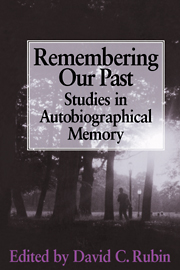Book contents
- Frontmatter
- Contents
- List of contributors
- 1 Introduction
- Part I Approaches
- Part II Accuracy
- Part III Emotions
- Part IV Social functions
- 11 Remembering as communication: A family recounts its past
- 12 Group narrative as a cultural context of autobiography
- 13 Memories of college: The importance of specific educational episodes
- Part V Development and disruption
- Subject index
- Author index
11 - Remembering as communication: A family recounts its past
Published online by Cambridge University Press: 14 October 2009
- Frontmatter
- Contents
- List of contributors
- 1 Introduction
- Part I Approaches
- Part II Accuracy
- Part III Emotions
- Part IV Social functions
- 11 Remembering as communication: A family recounts its past
- 12 Group narrative as a cultural context of autobiography
- 13 Memories of college: The importance of specific educational episodes
- Part V Development and disruption
- Subject index
- Author index
Summary
Remembering can be viewed as an act of communication. People remember their life stories by writing autobiographies, conversing with relatives, friends, and strangers, or even by talking to themselves. Their autobiographical memories emerge out of these varying forms of discourse. We cannot divorce the act of remembering from the act of communicating, nor can we treat an autobiographical memory as something distinct from the discourse itself. Recollections arise not from the depths of a storehouse in the head, but from a desire to communicate with others about the personal past. What is remembered and how it is remembered are functions of the resulting discourse. People remember the same episode differently when writing an autobiography, speaking to a group of strangers, reminiscing with a close friend, or conducting an internal dialogue (see Barclay, this volume; Pillemer, Krensky, Kleinman, Goldsmith, & White, 1991; Pillemer, Rhinehart, & White, 1986; Robinson, this volume; Tenney, 1989). The social conventions of autobiographical writing or speaking, the role of the audience, ordinary language assumptions, the embeddedness of meaning in context, the social interactions between speaker and audience – all shape the form and as well as the content of remembering. Othello reports that Desdemona's father “questioned me the story of my life,” but the story Othello remembered and told to the father was surely not so “passing strange” and “wondrous pitiful” as the tale that provoked in Desdemona a “world of sighs.”
- Type
- Chapter
- Information
- Remembering our PastStudies in Autobiographical Memory, pp. 271 - 290Publisher: Cambridge University PressPrint publication year: 1996
- 36
- Cited by



